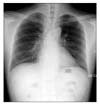Abstract
Kaposi's sarcoma occurs in higher rates in the setting of immunosuppression, especially in patients with acquired immunodeficiency syndrome (AIDS), immunosuppressive therapy or posttransplantation, commonly involving the skin, visceral, oral cavity or respiratory tract. Of the de novo malignancies in transplantation patients, the incidence of Kaposi's sarcoma is increasing steadily. We report a case of a 37-year-old male patient who was diagnosed with Kaposi's sarcoma 16 years after his first renal transplantation and 5 months after his second transplantation. He presented with lymphoproliferative lesions in the mediastinum and supraclavicular area without showing any typical cutaneous lesions. Diagnosis was confirmed by gun biopsy of the enlarged axillary lymph nodes. Tacrolimus, the initial immunosuppressive drug, was tapered while sirolimus therapy and chemotherapy with vincristine was initiated. The enlarged lymph nodes decreased in size and the patient has been treated with vincristin and conversion of tacrolimus to sirolimus.
Figures and Tables
 | Fig. 3Severely enlarged lymph nodes in the paraaortic space and mesenteric space. And multiple and massive lymph nodes in the celiac axis region around the pancreas and SMA. |
 | Fig. 4Extensive lymph node enlargement in all mediastinum including both hilum, interlobar and subcarinal areas are demonstrated. Tracheal compression also noted due to extensive lymphadenopathy. |
References
1. Giovanni S, Antonio S, Barbara I, Salvatoore D. Sirolimus for kaposi's sarcoma in renal-transplant recipients. N Engl J Med. 2005. 352:1317–1323.
2. Antman K, Chang Y. Kaposi's sarcoma. N Engl J Med. 2000. 342:1027–1038.
3. Lebbe C, Euvrard S, Barrou B, Pouteil-Noble C. Sirolimus conversion for patients with posttransplant kaposi's sarcoma. American J Transplantation. 2006. 6:2164–2168.
4. Shepherd FA, Maher E, Cardella C, Cole E, Greig P, Wade JA, et al. Treatment of Kaposi's sarcoma aftre solid organ transplantation. J Clin Oncol. 1997. 15:2371–2377.
5. Brambilla L, Boneschi V, Taglioni M, Ferrucci S. Staging of classic Kaposi's sarcoma: a useful tool for therapeutic choices. Eur J Dermatol. 2003. 13:83–86.
6. Chun HS, Park SC, Choi BS, Yang CW, Moon IS, Go WB. Second and third kidney transplantation in the catholic organ transplantation center. J Korean Soc Transplant. 2006. 20:69–72.
7. Mahendra L, Robert D, Yong-fang K, John A. Risk of malignancy wih long-term immunosuppression in renal transplant recipients. Kidney International. 2004. 66:383–389.
8. Chun EY, Kim SH, Yang UI, Lee MG. Kaposi's sarcoma: a Clinico-Pathological Study of 21 patients. Korean J Dermatol. 2003. 41:1603–1611.
9. Hudnall SD, Rady PL, Trying SK, Fish JC. Hydrocortisone activation of human herpes 8 viral DNA replication and gene expression in vitro. Transplantation. 1999. 67:648–652.
10. Choi WG, Kim JM, Kwon SR, Lee MH, Lee JS, Park W. A case of Kaposi's sarcoma in a Systemic Lupus Erythematosus patient after long term immune suppression. Korean J Rheumatol. 2006. 13:75.




 PDF
PDF ePub
ePub Citation
Citation Print
Print






 XML Download
XML Download